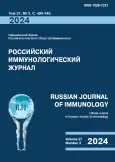Маркеры системного воспаления при геморрагическом инсульте с эффективным и неэффективным мозговым кровотоком
- Авторы: Бочкарев П.Ю.1, Береснева Н.С.1, Зудова А.И.2, Соломатина Л.В.2, Гусев Е.Ю.2
-
Учреждения:
- ГАУЗ Свердловской области «Свердловская областная клиническая больница № 1»
- ФГБУН «Институт иммунологии и физиологии» Уральского отделения Российской академии наук
- Выпуск: Том 27, № 3 (2024)
- Страницы: 621-626
- Раздел: КРАТКИЕ СООБЩЕНИЯ
- URL: https://bakhtiniada.ru/1028-7221/article/view/267532
- DOI: https://doi.org/10.46235/1028-7221-16659-MOS
- ID: 267532
Цитировать
Полный текст
Аннотация
Нейровоспаление при внутримозговом кровоизлиянии инициируется продуктами распада крови в субарахноидальном пространстве и/или паренхиме головного мозга. При этом нейровоспаление может являться причиной развития системного воспаления. В ряде случаев внутримозговое кровоизлияние сопровождается появлением феномена неэффективного мозгового кровотока и клинических проявлений смерти мозга. Цель исследования – выявить маркеры системного воспаления при тяжелом геморрагическом инсульте с наличием или отсутствием эффективного мозгового кровотока. В исследование для определения маркеров системного воспаления были включены пациенты с внутримозговым кровоизлиянием и наличием синдрома полиорганной недостаточности, а также комы в первые сутки манифестации. Всего было проанализировано 3 группы: пациенты с неэффективным мозговым кровотоком (группа 2), с эффективным мозговым кровотоком (группа 3); и контрольная группа (группа 1) – здоровые доноры крови. Критерии невключения в исследование: наличие у пациентов с геморрагическим инсультом септических осложнений в период госпитализации и острых инфекционных заболеваний при манифестации внутримозгового кровоизлияния. В замороженных образцах плазмы крови (антикоагулянт – цитрат) определяли уровни IL-6, IL-8, IL- 10, TNFá, прокальцитонина, нейронспецифической энолазы, кортизола, миоглобина, тропонина I и D-димеров. Иммуноферментный анализ проводился на автоматическом анализаторе Dynex Lazurite (Dynex Technologies, США). Критерий Колмогорова–Смирнова использовался для подтверждения нормальности распределения данных. Дальше сравнение количественных данных проводилось с использованием непараметрического U-критерия Манна–Уитни. Все результаты считались статистически значимыми при p < 0,05. У пациентов с эффективным и неэффективным мозговым кровотоком статистически значимые различия отмечались практически по всем исследуемым маркерам системного воспаления, кроме тропонина I. Однако при наличии эффективного мозгового кровотока отмечались существенно более высокие значения ряда показателей, что может говорить о более стремительно протекающем остром системном воспалительном ответе. При этом 28-суточная летальность и балл по шкале SOFA в группе с наличием эффективного кровотока при этом были ниже, чем в группе с неэффективным кровотоком. Такое несоответствие может указывать на больший вклад в 28-суточную летальность и тяжесть состояния пациента непосредственное выпадение функций мозга, чем вклад системного воспаления у пациентов с неэффективным кровотоком. С другой стороны, не выраженность системного воспаления у этой категории пациентов скорее всего связана с нарушением оттока крови из поврежденного мозга и поступлением в системный кровоток продуктов тканевого распада и других провоспалительных факторов. То есть внутримозговое кровоизлияние сопровождается развитием нейровоспаления, которое может являться важной составляющей системного воспаления. Однако нарушение притока и оттока крови в основных магистральных сосудах мозга снижает вероятность и выраженность развития системного воспаления.
Полный текст
Открыть статью на сайте журналаОб авторах
П. Ю. Бочкарев
ГАУЗ Свердловской области «Свердловская областная клиническая больница № 1»
Автор, ответственный за переписку.
Email: slv10@list.ru
заведующий отделением лабораторной диагностики
Россия, ЕкатеринбургН. С. Береснева
ГАУЗ Свердловской области «Свердловская областная клиническая больница № 1»
Email: slv10@list.ru
врач отделения лабораторной диагностики
Россия, ЕкатеринбургА. И. Зудова
ФГБУН «Институт иммунологии и физиологии» Уральского отделения Российской академии наук
Email: slv10@list.ru
младший научный сотрудник лаборатории иммунологии воспаления
Россия, ЕкатеринбургЛ. В. Соломатина
ФГБУН «Институт иммунологии и физиологии» Уральского отделения Российской академии наук
Email: slv10@list.ru
к.м.н., старший научный сотрудник лаборатории иммунологии воспаления
Россия, ЕкатеринбургЕ. Ю. Гусев
ФГБУН «Институт иммунологии и физиологии» Уральского отделения Российской академии наук
Email: slv10@list.ru
д.м.н., профессор, заведующий лабораторией иммунологии воспаления
Россия, ЕкатеринбургСписок литературы
- Alsbrook D.L., Di Napoli M., Bhatia K., Biller J., Andalib S., Hinduja A., Rodrigues R., Rodriguez M., Sabbagh S.Y., Selim M., Farahabadi M.H., Jafarli A., Divani A.A. Neuroinflammation in acute ischemic and hemorrhagic stroke. Curr. Neurol. Neurosci. Rep., 2023, Vol. 23, no. 8, pp. 407-431.
- Brazhnikov A., Zotova N., Solomatina L., Sarapultsev A., Spirin A., Gusev E. Shock-associated systemic inflammation in amniotic fluid embolism, complicated by clinical death. Pathophysiology, 2023, Vol. 30, no. 1, pp. 48-62.
- Lochhead J.J., Yang J., Ronaldson P.T., Davis T.P.. Structure, function, and regulation of the blood-brain barrier tight junction in central nervous system disorders. Front. Physiol., 2020, no. 11, 914. doi: 10.3389/fphys.2020.00914.
- Simats A., Liesz A. Systemic inflammation after stroke: implications for post-stroke comorbidities. EMBO Mol. Med., 2022, Vol. 14, no. 9, e16269. doi: 10.15252/emmm.202216269.
- Tschoe C., Bushnell C.D., Duncan P.W., Alexander-Miller M.A., Wolfe S.Q. Neuroinfammation after intracerebral hemorrhage and potential therapeutic targets. J. Stroke, 2020, Vol. 22, no. 1, pp. 29-46.
- Zotova N., Zhuravleva Y., Chereshnev V., Gusev E. Acute and chronic systemic inflammation: features and differences in the pathogenesis, and integral criteria for verification and differentiation. Int. J. Mol. Sci.s, 2023, Vol. 24, no. 2, 1144. doi: 10.3390/ijms24021144.
Дополнительные файлы







